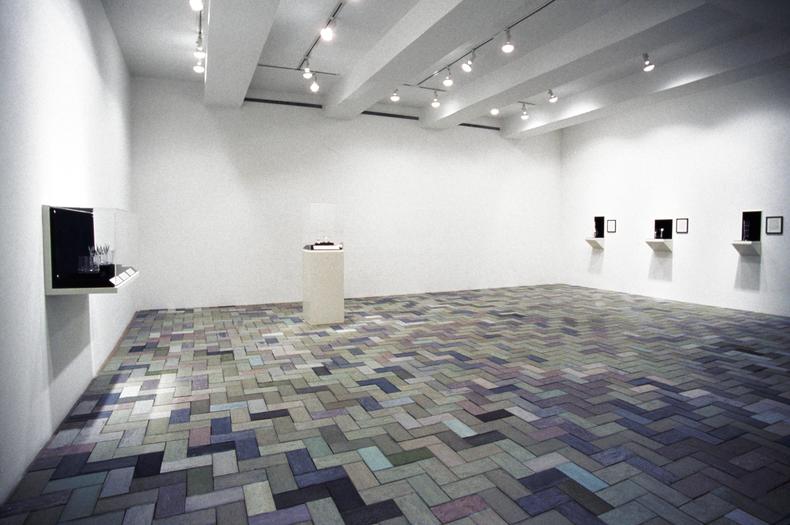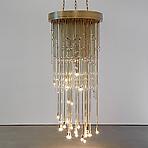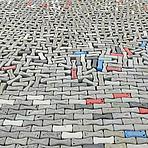Josiah McElheny and Dan Peterman
January 21 – February 25, 1995
Main Gallery
DAN PETERMAN
The floor covering is 100% post-consumer reprocessed plastic: milk jugs, pop bottles, food, soap, shampoo containers, etc. Its color comes from a broad spectrum of colors aimed at consumer tastes and habits, but now, like a muddled pallet, tends toward gray-green. This gallery installation weights a little over 1 1/2 tons and roughly equals the per capita annual plastic consumption of 20 Americans.
The most immediate question is not whether reprocessed plastic is a suitable material for floor covering but whether the floor is a suitable place to store reprocessed plastic. We increasingly feed on our own waste, but plastic is not drawn in to continual recycling loops, not yet anyway. It tends to degrade at each turn. The change from the precise high tolerance films used in packaging to rather brute contaminated extrusions is one quick step, leaving it rather disconnected and therefore open to question. Reprocessing of waste plastic began despite there being no clear need for the end product. The common perception was that extruding waste plastic into continuous multi-color streams was an option more palatable to the public than endless landfilling or primary mission is to seem purposeful enough to deflect critique from the mother industry. In other words the recovery of waste serving to justify the further production of waste.
There is a fluid , nomadic quality to this material, like houses increasingly composed of recycled domestic wastes, and automobiles composed of the preceding generation of automobiles. This fluidity requires shape and measure and limits, a task which perhaps best outlines the sculptural project. As with Lewis Carroll's map scaled 1:1 with the landscape, the ultimate scale here is set by the petrochemical means of production and our insatiability as consumers. Within this scale, aesthetic, economic, sociological, and ecological considerations all seem to provide viable units of measure. But perhaps the most important task at hand is to hold off any single dominant reading and simply let it run, fill the room, become as big as it can.
Increasingly, resource and residue are perceived as indistinguishable - part of the same swirling economic, and ecological pool. Recent developments at the Chicago Board of Trade, such as the SO2 emission rights program, and a market for recycled materials, are evidence of this. The dollar value of this material is difficult to pin down. It goes from zero value (actually less than zero if one takes into account the burden of waste handling ) to being priced in its final, extruded, state somewhere beyond pressure-treated lumber. It has, in addition, a difficult to establish "green" value for having been diverted from either landfill or incineration thereby not in some way further degrading the environment. As time goes on and plastic technology expand and refines, it is likely that the value of dense, readily accessible plastics like this will increase. In other words its value as a stockpile could eventually far exceed its use value.
Is floor-covering a purely functional or aesthetic application? an eco-gesture? Is it a speculators stockpile? a domestic landfill? What new meaning or value will the future bring as uses develop and ecological perspectives change? Should a new layer be put down each year to accommodate continued consumption? Is the gallery dutifully, if only temporarily, acknowledging that, given the inevitability of this matter occupying space somewhere, then why not here? In the end, the humble question arises, "is there any fundamental difference in the meaning between installing this material in the gallery and placing it in storage"?
JOSIAH MCELHENY
An exhibition of historical glass, titled "For Victoria".
The exhibition is of pieces made by traditional factory glassblowers in Sweden, Italy and Germany during their lunch break; some are replicas blown by the artist. Glass factory workers used their only free glass shop time to make items for special occasions in their own family. Actual glass bridal crowns (including the Swedish Queen Kristina's) from the 16th and 17th century as well as 20th century birth gifts (glass pacifier and glass baby chamber pot) from Sweden are exhibited along with McElheny's replicas of 16th and 18th century Italian and 15th century German glass.
McElheny has handblown and engraved replicas of the famous Rose in the Bottle (originally an engagement present), the First Glass Loving Cups (originally for wedding ceremonies), and the Anniversary Passglass (a well known German marriage anniversary cup). McElheny is offering replicas of these three pieces on a commission basis for couples only. Each are available hand engraved with the appropriate names, and includes certified documentation.


